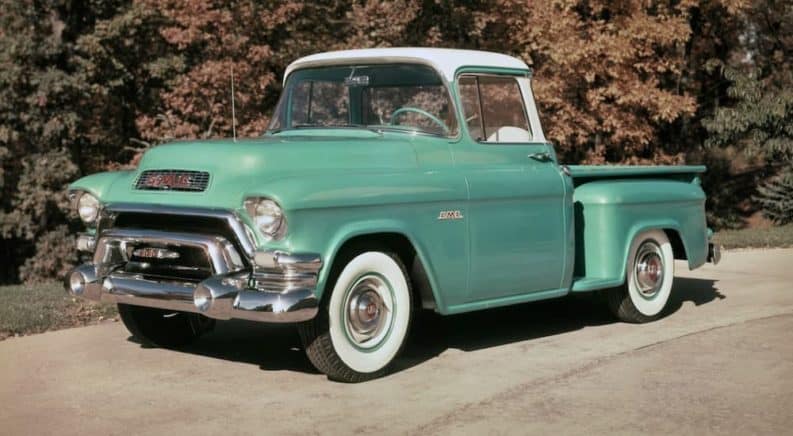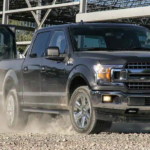Trucks are tied to American culture in much the same way as apple pie, as a symbol of our roots of ingenuity, hard work, and a desire to improve on what we have. The evolution of the truck takes a fascinating route across American history, beginning with GM commercial trucks being built in Detroit back in 1902, and then later working folks were strapping wagon beds or cargo boxes straight onto their Model T chassis to haul things more easily. The first lighter duty trucks for sale from a manufacturer didn’t show up on the market until 1924, but trucks became an indispensable part of both work and play in only a couple of decades. Today, we see people driving trucks as symbols of luxury and status, a far cry from farmers bootstrapping a means to get their wares to town.
The First GM Trucks
In 1900, the Grabowski brothers formed the Grabowski Motor Vehicle Company in Detroit. Their first truck prototype was built for commercial use and featured a single-cylinder engine with two speeds. It could only go 10 miles per hour, but it had a capacity of one ton. A year later, they built their second truck with two cylinders to improve on the first, which they felt was underpowered. It sold to a garment company in Detroit and may have been the first gasoline-powered vehicle in the city at the time.
By 1911 GMVC had already gone through several reorganizations and partnerships, with the results leading toward building more vehicles, both commercial and passenger. In this particular year, the Grabowski’s formed the new company called the General Motors Truck Company, which was to be traded under copyright as GMC. Already in one decade of business, GM trucks were being built and sold as commercial delivery wagons which had capacities ranging from one-half ton to six tons and were available in dozens of models, including nine electric models. Records were set with feats like the first commercial vehicle to drive Pikes Peak in Colorado.
The first passenger buses were also built during this time and were being enclosed with canopy tops, which could be screened in for passenger comfort. Innovations were consistently part of the company operations, as more cylinders were added to the engines for better horsepower, and new designs were being created on a regular basis. 1912 was the first year GMC logos were seen by the public on trucks displayed at a New York City auto show.
Just a few short years later, in 1914, GMC came out with the first of its new trucks designed for light-duty delivery, which were built by the Buick Motor Company on a Buick chassis. These trucks could be had for a price of $1,090, and the option of a cab with a windshield or “express cargo body” cost extra. It was the following year that saw the formation of GMC’s truck division.
GMC Trucks Around the World
It didn’t take long for the word to spread about the usefulness and capability of GM trucks. In World War I, the British used several GM trucks in service, as did the US army, which utilized GM ambulances, troop carriers, and trucks for light aviation support. By 1918, the year WWI ended, 90% of GM trucks were being built for Ally use. The 1920s became a booming business for GM, with a new plant in Canada, a new organization under the management of Alfred P. Sloan, and a consolidation of the sprawling mess that had become a large number of businesses under the wider GM umbrella. Sloan assigned the company names by which they became world-renowned: Chevrolet, Buick, Pontiac, Cadillac, and Oldsmobile.
Under the guidance of Sloan, GM companies began introducing new designs on a yearly schedule, which is still observed in car manufacturing today. A fast-paced rivalry with Ford Motors Company resulted in a victory for GM in 1929 when GM out-sold Ford in America in passenger car sales. In the 1930s, the Great Depression caused sales to bottom out, which forced lay-offs and slowed the development of new designs. Fortunately, GM weathered the depression and came back with new innovations. The Chevy division designed and produced the Suburban Carryall during the 1930s—the first SUV from GM—which was built on a truck chassis.
Also popular for that time were the two-tone Art Deco designs for trucks, but then World War II demanded more military innovations with the first six-wheel drive Jimmies. GM also developed garbage trucks, tankers, and fire engines, further spreading the company’s reach into world business organizations. Once the 1950s rolled around, the US was feeling its prosperity fully again, and pickups became more than the working man’s vehicle of choice. Suburbans and vans also grew in popularity for the general public, as well as recreational vehicles for camping and leisure. From there, trucks became indispensable as America fell in love with a multi-use cargo vehicle that exhibited supreme versatility.
GM Light Duty Trucks Over the Decades
From the beginning, GM trucks have been big and beefy, built to work hard and haul. Though GMC is known for its commercial truck manufacturing, it’s had a long history of building lighter duty trucks, too. In 1927, GM began rolling out the T series trucks, which had either panel or screen sides and were fitted with Pontiac engines. The T series was built throughout the 1930s until 1939 when the new AC100 models were introduced.
The early to mid-1940s came out with GM’s AK series of light-duty trucks, which were also marketed and sold at Chevy dealerships. In 1946 and 1947, GM distinguished this line of trucks as C and E series, but then shortly followed up with “New-Design” trucks, which were made to be bigger and stronger. This series lasted until 1955 when the Blue Chip series was introduced with options like the first V8 engine, two-tone paint, and a choice of bed sizes from six to eight feet.
Finally, in 1960 began the “first generation” of GM and Chevy trucks known as the C/K series. This started the lines of trucks we know today as Silverado and Sierra, but in the first generation, the C stood for two-wheel drive, and K stood for four-wheel drive. These trucks had several features which were firsts for this truck series, including a lower cab and an independent front suspension. Though this generation saw improvements to make the driving experience more car-like, it was the second generation in 1967, which took GM trucks into more luxurious comforts to appeal to a wider group of buyers.
Third generation C/K trucks were marketed in 1973, with bodies that looked nothing like any other truck, and its parts were being tested in simulators. The fourth-generation didn’t come out until 1988 and was the first to offer an extended cab… Long after the first extended cabs were introduced by Dodge in 1973. Ten years later, in 1998, the first GMC Sierra and Chevy Silverado lines hit dealerships using names drawn from models of the older C/K series trucks. Since then, available models have expanded from light duty to heavy duty, and the options are seemingly endless in a salute to the consistent innovation over the history of GM design and engineering.
Aside from the standard pickup trucks GM offered, other variants came and went over the years. The GMC Sprint/Caballero was a coupe that had a truck bed on the back end and was available from 1971 to 1987. A compact pickup called the S15 was available from 1982-91, and became the Sonoma until 1993. In 2004 the Sonoma became today’s Canyon. The number of trucks built and produced by GM over the last 100 years are truly astonishing, not only for the variety but also for the usefulness. Today GM still produces trucks that span everything from the farm to the military and even off-roading trucks. American history has trucks driving all through it, and GM has been right in the thick of it all.






